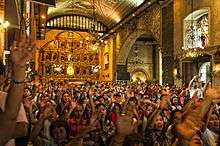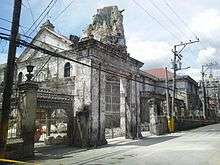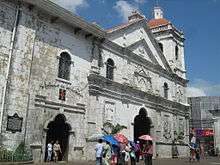Basilica del Santo Niño
| Minor Basilica of the Holy Child | |
|---|---|
| Basílica Minore del Santo Niño de Cebú | |
|
The Basílica Minore del Santo Niño is the Mother and Head of All Churches in the Philippines. | |
.svg.png) Minor Basilica of the Holy Child Location in the Philippines | |
| 10°17′38″N 123°54′5″E / 10.29389°N 123.90139°E | |
| Location | Cebu City |
| Country | Philippines |
| Denomination | Roman Catholic |
| Website | Official website |
| History | |
| Former name(s) | Church and Convent of Saint Augustine[1] |
| Founded | April 28, 1565 |
| Founder(s) |
Fray Andres de Urdaneta, O.S.A. Fray Diego de Herrera, O.S.A. |
| Consecrated | 1739[1] - 1740[2] |
| Relics held | Santo Niño de Cebú |
| Architecture | |
| Status | Basilica |
| Functional status | Active |
| Heritage designation | National Historical Landmark |
| Designated | 1941 |
| Architect(s) | Fray Juan de Albarran, O.S.A. |
| Architectural type | Church and convent |
| Style | Earthquake Baroque |
| Groundbreaking | 1735 |
| Completed | 1739-1740 |
| Specifications | |
| Number of domes | None |
| Materials | Stone[1] |
| Administration | |
| Archdiocese | Roman Catholic Archdiocese of Cebu |
| Province | Augustinian Province of Sto. Niño de Cebu - Philippines |
| Clergy | |
| Archbishop | Jose Serofia Palma, D.D. |
| Rector | Rev. Fr. Jonas M. Mejares, O.S.A. |
| Priest in charge | Rev. Fr. Rodolfo Bugna, O.S.A. |
The Minor Basilica of the Holy Child (Cebuano: Basilica Menore del Santo Niño Spanish: Basilica del Santo Niño and Filipino: Basilica Menor del Santo Niño) and commonly known as the Santo Niño Basilica, is a minor basilica in Cebu City in the Philippines that was founded in the 1565 by Frays Andrés de Urdaneta, O.S.A. and Diego de Herrera, O.S.A.. The oldest Roman Catholic church in the country, it is built on the spot where the image of the Santo Niño de Cebú was found during the expedition of Miguel López de Legazpi. The icon, a statue of the Child Jesus, is the same one presented by Ferdinand Magellan to the chief consort of Rajah Humabon upon the royal couple's christening on April 14, 1521. It was found by a soldier forty years later, preserved in a wooden box, after Legazpi had razed a local village.[1] When Pope Paul VI made the church a basilica in 1965, he said it is "the symbol of the birth and growth of Christianity in the Philippines."[3]
The present building, which was completed from 1739-1740, has been designated by the Holy See as the "Mother and Head of all Churches in the Philippines" (mater et caput... omnium ecclesiarum Insularum Philippinarum).[4]
History
Previous churches
The church of the Holy Child was founded by the Augustinians led by Andrés de Urdaneta and Diego de Herrea on April 28, 1565. The first church and convent were built out of earth, hard wood and nipa. Both structures burned down on November 1, 1566. In 1605, Rev. Pedro Torres started the construction of its replacement. The second church was completed in 1626, but was also destroyed by fire, in March 1628. It was rebuilt immediately under the administration of Rev. Juan de Medina[5] with stone and bricks, but construction was stopped because of problems with the integrity of the bricks being used.[1]
Present church
Fernando Valdés y Tamon, the Spanish governor of the Philippines, ordered the church in 1735 to be constructed of hard stone. Father Provincial Bergaño, Governor-General Fernando Valdes, Bishop Manuel Antonio Decio y Ocampo of Cebu and Rev. Juan de Albarran, Prior of the Santo Niño, started the foundations of the church on 29 February 1735.[1] Construction was designed and led by Rev. Juan de Albarran, and it was completed in 1739 or 1740.[2] The convent and library were later added and completed in 1764.
In 1965, during the fourth centenary of the Christianization of the Philippines, Pope Paul VI elevated the church to the rank of minor basilica; it remains under the care of the Order of St. Augustine.
Pilgrim Center
The masses on Fridays were moved to the newly constructed Pilgrim Center in September 1990 to accommodate more worshippers. The open-air theater-like structure is located in the Basilica Complex right in front of the basilica and has a capacity of about 3,500.[1]
2013 Bohol earthquake
On October 15, 2013, at approximately 8am GMT+8, a 7.2-magnitude earthquake shook Tagbilaran, Bohol, its force felt throughout the Visayas. It caused more than 120 casualties, and much damage to buildings, historical landmarks and churches. The earthquake destroyed most of the Basilica's belfry and façade; some walls and frescoes were cracked. A video of the collapse can be seen here. The building was soon restored and later re-opened to the public. The bell tower is now fully repaired and the main door of the church as well as the area in between the original church and the pilgrim center is now fully accessible however the right wing is still not fully accessible to the public due to clearing and completion.
Museum
There is a museum inside the Basilica complex, with exhibits relating to the history of Christianity in Cebu. Antique relics are on display, including century-old furniture, priestly vestments and cloaks donated to the Santo Nino over the centuries. There are religious exhibits such as statues and relics, items of daily life from the adjacent convent, toys said to be gifts to the child Jesus, and a large Santo Niño rosary of 15 beads.
Basilica del Santo Niño Library
Originally for exclusive use by the friars, in the year 2000 the church library was opened to all serious nonclerical researchers. Its collection covers religious subjects and non-religious disciplines including history, science, philosophy, Filipiniana, and periodicals.[1]
Designation
The Church and Convent of Santo Niño was declared a National Historical Landmark in 1941.[2]
Location
The Basílica Menor del Santo Niño de Cebu Basilica Complex is located in city block bordered by Osmeña Boulevard, D. Jakosalem St, P. Burgos St. and the Plaza Sugbo where the Magellan's Cross is located. The main entrance is on Osmeña Boulevard. Two blocks north of the basilica is the Cebu Metropolitan Cathedral, the seat of the Roman Catholic Archdiocese of Cebu.
Gallery
-

Interior of the Basilica del Santo Niño
-
The frescoes on the ceiling of the Basilica
-

Inside the Basilica
-

Candle lighting for prayer at the Sto. Niño Church
-

Mass celebrated at the Pilgrim Center in front of the Basilica
-

After the 2013 Bohol earthquake.
References
- 1 2 3 4 5 6 7 8 "Basilica Complex". Basilica del Santo Niño. Retrieved on 2013-01-30.
- 1 2 3 "Church and Convent of Santo Niño". National Registry of Historic Sites and Structures of the Philippines.Retrieved on 2013-01-31.
- ↑ "Archived copy". Archived from the original on 2013-03-03. Retrieved 2014-07-18.
- ↑ "Archived copy". Archived from the original on 2013-03-02. Retrieved 2014-09-10.
- ↑ "Administration". Basilica del Santo Niño. Retrieved on 2013-01-30.
External links
| Wikimedia Commons has media related to Basilica of Santo Niño (Cebu). |
- Official website of the Basílica Menor del Santo Niño
- The Augustinians in the Philippines
- The image of the Santo Niño, which is kept in the parish convent, is considered the oldest religious relic in the Philippines
